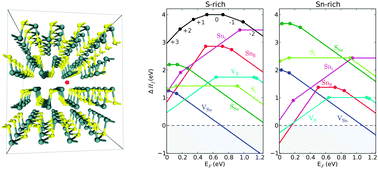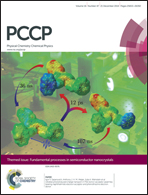First principles study of point defects in SnS†
Abstract
Photovoltaic cells based on SnS as the absorber layer show promise for efficient solar devices containing non-toxic materials that are abundant enough for large scale production. The efficiency of SnS cells has been increasing steadily, but various loss mechanisms in the device, related to the presence of defects in the material, have so far limited it far below its maximal theoretical value. In this work we perform first principles, density-functional-theory calculations to examine the behavior and nature of both intrinsic and extrinsic defects in the SnS absorber layer. We focus on the elements known to exist in the environment of SnS-based photovoltaic devices during growth. In what concerns intrinsic defects, our calculations support the current understanding of the role of the Sn vacancy (VSn) acceptor defect, namely that it is responsible for the p-type conductivity in SnS. We also present calculations for extrinsic defects and make extensive comparison to experimental expectations. Our detailed treatment of electrostatic correction terms for charged defects provides theoretical predictions on both the high-frequency and low-frequency dielectric tensors of SnS.


 Please wait while we load your content...
Please wait while we load your content...